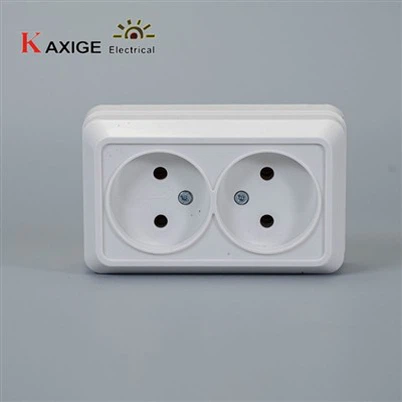How long do old switches and sockets typically last?
Leave a message
As a seasoned supplier of old switches and sockets, I've often been asked about the typical lifespan of these essential electrical components. In this blog, I'll delve into the factors that influence their longevity, provide estimates for different types of switches and sockets, and offer some tips on how to extend their useful life.
Factors Affecting the Lifespan of Switches and Sockets
The lifespan of old switches and sockets can vary significantly depending on several key factors. Understanding these factors is crucial for both consumers and professionals in the electrical industry.
Quality of Materials
The quality of materials used in the manufacturing of switches and sockets plays a fundamental role in determining their durability. High - quality materials such as copper for contacts and flame - retardant plastics for the housing are more resistant to wear, corrosion, and heat. For example, switches with silver - plated contacts tend to have better conductivity and less resistance, which reduces the amount of heat generated during operation and extends their lifespan. Cheaper materials may degrade more quickly, leading to premature failure.
Frequency of Use
How often a switch or socket is used is another important factor. A switch in a frequently used room, like a living room or a kitchen, will be turned on and off much more often than one in a rarely used storage room. The mechanical wear and tear caused by repeated switching actions can gradually damage the internal components of the switch. Similarly, sockets that are constantly plugged and unplugged are more likely to experience wear on their contacts.
Environmental Conditions
The environment in which switches and sockets are installed can have a significant impact on their lifespan. Exposure to moisture, dust, extreme temperatures, and corrosive substances can all cause damage. For instance, switches and sockets in a bathroom or a basement are more prone to moisture, which can lead to rusting of the contacts and short - circuits. In industrial settings, where there may be high levels of dust or chemicals, the lifespan of these components can be severely reduced.
Installation Quality
Proper installation is essential for the long - term performance of switches and sockets. Incorrect wiring, loose connections, or improper grounding can cause overheating, arcing, and other electrical problems that can shorten their lifespan. A professional electrician should always be consulted for the installation of electrical components to ensure they are installed correctly.
Lifespan Estimates for Different Types of Switches and Sockets
Standard Light Switches
Standard light switches, which are the most common type found in residential and commercial buildings, typically have a lifespan of 10 to 20 years. These switches are designed to handle a certain number of switching cycles, usually in the range of 10,000 to 100,000 cycles. However, with proper use and in a favorable environment, they can last even longer.
Dimmer Switches
Dimmer switches, such as the 73B Dimmer Switch, are more complex than standard light switches. They contain electronic components that are more sensitive to heat and electrical fluctuations. As a result, their lifespan is generally shorter, ranging from 5 to 15 years. However, high - quality dimmer switches with good heat dissipation and surge protection can last closer to the upper end of this range.
Power Sockets
Power sockets are designed to handle the connection of electrical appliances. Their lifespan can vary depending on the type and frequency of use. Standard 1 - gang sockets, like the 73B 1 Gang Socket Grounding and 73B 1 Gang Socket 2P, can last between 15 and 25 years under normal conditions. However, sockets that are used to power high - wattage appliances or are subject to frequent plugging and unplugging may need to be replaced more frequently.
Tips to Extend the Lifespan of Switches and Sockets
Regular Maintenance
Regularly inspect switches and sockets for signs of damage, such as loose connections, discoloration, or burning smells. Clean them gently with a dry cloth to remove dust and debris. If any problems are detected, have them repaired or replaced immediately.
Use Surge Protectors
Surge protectors can help protect switches and sockets from electrical surges caused by lightning strikes or power grid fluctuations. By absorbing the excess voltage, surge protectors can prevent damage to the internal components of these electrical devices.
Avoid Overloading
Do not overload sockets by plugging in too many high - wattage appliances at once. Overloading can cause overheating, which can damage the contacts and other components of the socket. Make sure to distribute the load evenly across multiple sockets.
Upgrade When Necessary
As technology advances, newer switches and sockets may offer better performance and safety features. Consider upgrading your old switches and sockets to more modern models, especially if they are showing signs of wear or if you are renovating your home or office.
Conclusion
In conclusion, the lifespan of old switches and sockets can vary widely depending on factors such as the quality of materials, frequency of use, environmental conditions, and installation quality. While standard light switches can last 10 to 20 years, dimmer switches may have a shorter lifespan of 5 to 15 years, and power sockets can last between 15 and 25 years under normal conditions. By following the tips mentioned above, you can extend the lifespan of these essential electrical components.
If you are in the market for high - quality old switches and sockets, I invite you to contact me for a detailed discussion about your requirements. I can provide you with a wide range of products that are designed to meet your needs and offer excellent durability. Whether you are a homeowner, a contractor, or an industrial user, I am committed to providing you with the best solutions for your electrical needs.


References
- Electrical Installation Handbook, Schneider Electric
- National Electrical Code (NEC)






